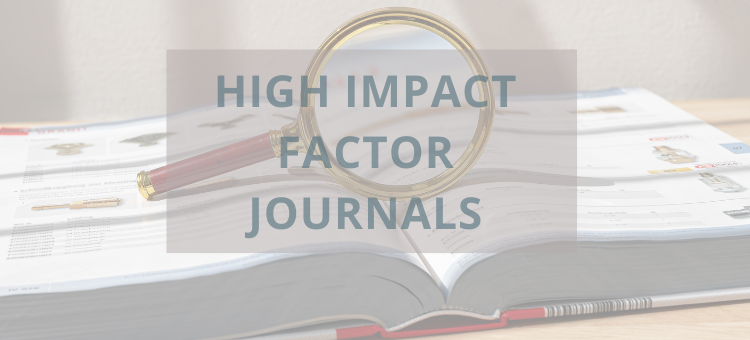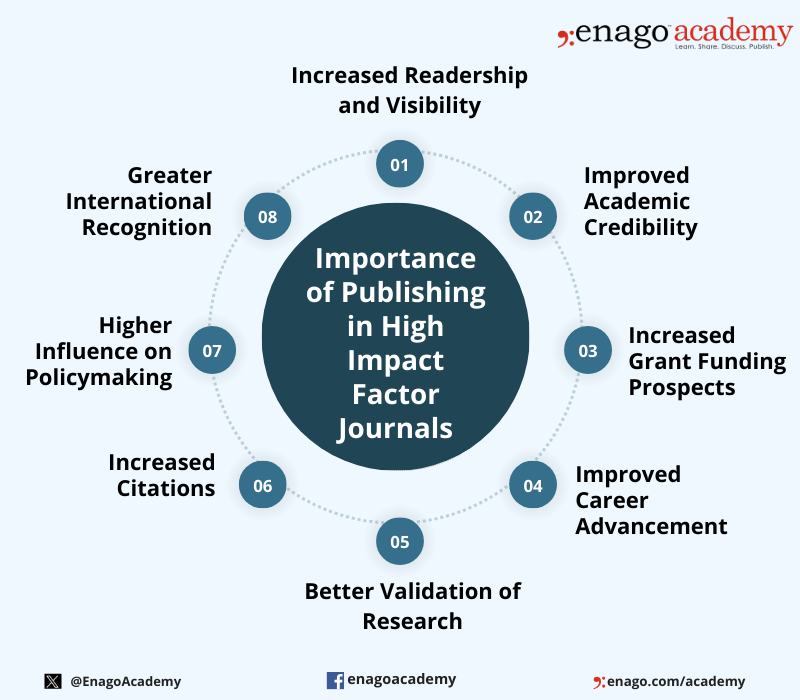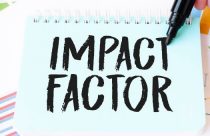High Impact Journals 2024 — Key to deciding the right journal

Publishing a manuscript can be a rewarding yet challenging endeavor. From enunciating research in the manuscript to selecting the right journal, researchers come a long way to get their work published. However, choosing the right journal to publish plays a pivotal role in shaping the trajectory of one’s scholarly impact. Submitting research to high impact factor journals carries significant weight in the academic landscape. The influence of high impact factor journals in broadening visibility and increasing citations cannot be ignored as they can enhance one’s impact in scholarly contributions.
Importance of Publishing in High Impact Factor Journals
Let’s address the fundamental question – What are impact factors and why should one aspire to publish in high impact factor journals? Impact Factor is a measure of the frequency with which the “average article” in a journal has been cited in a particular time period. It is commonly used as a metric to assess the importance or influence of a scientific journal in a specific field. The answer to their significance lies in the unparalleled visibility and credibility these journals provide.
When your work is published in a renowned publication, it not only reaches a wider audience but also establishes your expertise in the field. Here are some advantages of publishing in high impact factor journals:

The rigorous review process of these journals demand meticulous attention to detail, methodological robustness, and a clear explanation of the research’s broader implications. But, ever wondered how impact factor is calculated?
Calculating Impact Factor
Understanding this metric is crucial for navigating the publication landscape. The impact factor is derived by dividing the number of citations a journal receives in a given year by the total number of articles published in the previous two years. This numerical value offers insights into the journal’s influence and relevance within the scientific community. Higher impact factor generally signals broader interest and attention.

But, what can be the values for a good impact factor? Although the answer for this question is discipline-specific, the values can be used to compare journals in the same field. Therefore, it’s impossible to determine what a “bad” and a “good” impact factor is for academic journals from all fields. You can only compare the impact factor of a journal with other journals in the same category.
1. Good Impact Factor:
A good impact factor can vary by field, but in many scientific disciplines, an IF above 5 or 10 is often considered high.
2. Average Impact Factor:
In many fields, a journal with an impact factor between 1 and 5 might be considered average.
3. Low or Bad Impact Factor:
A journal with an impact factor between 0 and 1 might be considered low impact factor journals in several domains.
However, the above values do not strictly determine the “bad”, “good”, and “average” for academic journals, as different fields may have different norms and citation practices, which influence these numbers.
Top High Impact Factor Journals
Researchers often get perplexed on finding top high impact factor journals. To simplify your quest, here’s a list of top 20 high impact factor journals across various subject areas for 2024:
Sr. No. |
Journal |
Impact Factor |
| 1. | CA-A Cancer Journal for Clinicians | 254.7 |
| 2. | Lancet | 168.9 |
| 3. | New England Journal of Medicine | 158.5 |
| 4. | JAMA-Journal of the American Medical Association | 120.7 |
| 5. | Nature Reviews Drug Discovery | 120.1 |
| 6. | Nature Reviews Molecular Cell Biology | 112.7 |
| 7. | BMJ-British Medical Journal | 105.7 |
| 8. | Nature Reviews Immunology | 100.3 |
| 9. | World Psychiatry | 73.3 |
| 10. | Lancet Psychiatry | 64.3 |
| 11. | Chemical Reviews | 62.1 |
| 12. | Nature Climate Change | 30.7 |
| 13. | Science Robotics | 25 |
| 14. | European Journal of Epidemiology | 13.6 |
| 15. | Journal of Economic Perspectives | 9.944 |
| 16. | PRX Quantum | 9.7 |
| 17. | Journal of Financial Economics | 8.238 |
| 18. | Hepatobiliary Surgery and Nutrition | 8 |
| 19. | Fish and Fisheries | 6.7 |
| 20. | Economic History Review | 2.487 |
Note: Different fields may have different norms and citation practices, which influence these numbers and rankings.
After identifying the potential journals, it’s essential to approach the submission process strategically. In the era witnessed by the growing developments in Artificial Intelligence (AI), it’s important to understand how high impact factor journals view the technological advancements. From enhancing peer review process to leveraging algorithms for literature commendations, many journals embrace AI in various forms. Understanding the AI stance of your selected journal is crucial for adhering your work with their guidelines.
Are you still confused on how to publish in high impact factor journals? Watch this engaging webinar to navigate the path in publishing in your research in high impact factor journals.
Your research deserves a spotlight, and traversing through the impact factor maze can help you embark on a successful academic journey.
Frequently Asked Questions
Is 7 a good impact factor?▼
The perception of whether a specific impact factor (IF) is considered "good" can vary depending on the field of study. In general, an impact factor of 7 is considered quite high and indicates that the journal has a significant influence in its field. Here's a rough guide to interpreting impact factors:
1-2: Low impact
2-5: Moderate impact
5-10: High impact
10 and above: Very high impact
However, it's important to note different disciplines may have different expectations, and the significance of impact factors can vary. Researchers often consider additional factors such as the journal's reputation, audience, relevance to their field, and the specific goals of their research when deciding where to publish.
What is a high impact factor for journals?▼
The perception of an impact factor (IF) being considered "high" can vary depending on the field of study. Generally, an impact factor of more than 7 is considered high. However, different disciplines may have different norms and citation practices, which influence these numbers and rankings.
How to find high impact journals?▼
several methods to identify high-impact journals:
1. Check Journal Rankings
2. Explore Academic Databases
3. Seek Recommendations from Colleagues and Mentors
4. Check Previously Published Articles
5. Visit Journal Websites
What is the formula for impact factor?▼
Here is the formula to calculate impact factor: Impact factor for X year = [Number of citations in X year for all the resources published in (X-1) and (X-2) years]/ [Sum of the number of resources published in in (X-1) and (X-2) years].










Great post! Very straight to the point and provided insightful info!
Best wishes to be obliged for certain sense of aide.
thanks please keep sharing more updated readings .